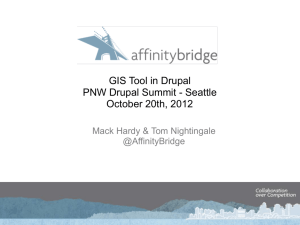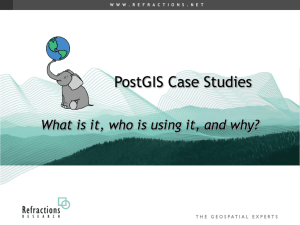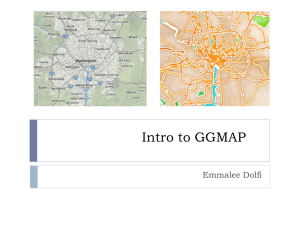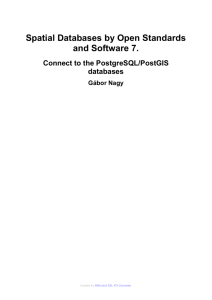PPT - TriLUG
advertisement
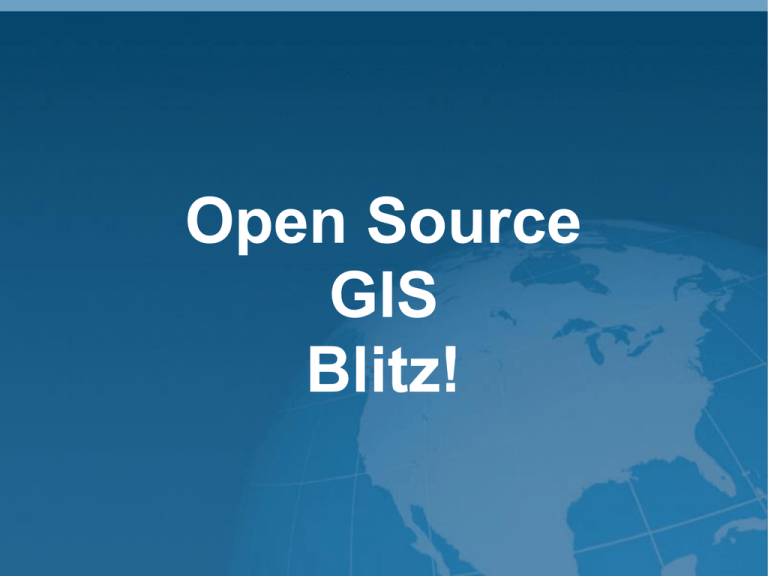
Open Source
GIS
Blitz!
Start with this video
http://vimeo.com/2598878
Openstreetmap.org
Crown copyright– no expiration – all government map data
in England.
Rest of Europe not much better
Volunteer mapping effort.
Bulk uploads of GPS data, vector data sets,
online editing using potlatch tool.
Open Geospatial Consortium (OGC) Data
Standards
WMS – Web Map Service
WFS-T - Web Feature Service.
WCS – Web Context Service
SOS – Sensor Observation Service
KML - Keyhole Markup Language
WPS – Web Processing System
Other Spatial Standards
GeoRSS
GeoJson
Libraries
Other Useful Libraies
Geos - http://geos.refractions.net
Java Topology Suite
http://www.vividsolutions.com/jts/jtshome.htm
Liblas - http://www.liblas.org - library for working with LAS
format Lidar data
Gdal - http://www.gdal.org
“Swiss army knife” of geospatial data
Features:
Interfaces for 61 Raster formats and 27 vector formats.
Reprojection of raster and vector datasets.
Merging and splitting raster and vector datasets.
Basic library used in many Open source GIS projects.
Cross-platform easy install Fwtools binaries with command line
utilites
Library interfaces to the following programming/scripting
languages:
Visual Basic 6 ( no swig)
C/C++
Perl
Python
Java – testing
Ruby – testing
C# - testing
R statistical programming
You may already be using gdal in your current GIS software!
The license allows for use in open source and commercial
products. Used in :
GRASS
UMN Mapserver
QGIS
ESRI ArcGIS 9.2+
Google Earth
and many more.
Scripting Image Manipulation
A case history – Converting the 1 image per
County NAIP UTM MrSID imagery to a
Seamless Layer of DOQQ Imagery in North
Carolina State Plane Projection.
Doug Newcomb
USFWS
December, 2007
Hardware and software
Hardware: USFWS Standard Dell Power User
Intel Core 2 Duo Workstation with 6GB RAM, 1x
80 GB SATA Hard drive, 1x 750 GB SATA hard
drive, 1x 500GB USB 2.0 hard drive
Software: Centos 5.0 64-bit Linux, Gdal ( compiled
with ECW library), FWTools (
http://fwtools.maptools.org)
Problem Description 1
Raster Imagery is
Rectangular
Counties are usually not
Rectangular
Problem Description 1a
Working with more than one County can
Problem Description 2
ones so much, we have 3 of them! Unfortunately UTM zo
e NC State Plane projection is standard for all of our state
gle projection in a regular tiled mosaic. The ideal would b
Reprojection of Imagery
y pixels are aligned to the coordinate system of the proje
Reprojection of Imagery
ntally aligned to the coordinate system of the new project
No Data Pixels
Reprojection of Imagery
No Data Pixels
ult when multiple reprojected images displayed together
Cookie cutting
No Data Pixels
art of each file that will match a DOQQ footprint, and then
DOQQ footprint
Solution: A free, open source tool
and a bit of python scripting
hat allow for the reprojection, merging and reformatting of
Python scripting in GDAL
GDAL has libraries that can be used in python tha
Unfortunately, I have not had the time to learn how
Gdal utilities used:
gdalwarp
gdaltindex
ogrinfo
http://www.gdal.org/gdal_utilities.html
ogr2ogr
gdal_translate
First Step: Converting the Mr.Sid
imagery to something useful
The MrSID dsdk libraries are a bit tricky to compile into gdal, so I ins
gdnearblack = "nearblack -o %s %s" % (imgfiletmp,path)
os.system(gdnearblack)
gdwarpcom = "gdalwarp -t_srs \"epsg:32119\"
os.system(gdwarpcom)
-of \"HFA\" %s %s" % (path,i
This command reprojects the MrSID imagery into the North Ca
Linux filesystem tricks
The sharp-eyed will notice that 900 GB is larger than the 750 GB SA
Later, I needed to have all of the files in the same directory for the p
ln -s /media/usb/*.img
/biggis/naip2006
This creates a link between where the files actually are and where I
Getting DOQQ corner
coordinates
Instead of calculating the corner coordinates for each quarter quad i
gdaltindex
1998doq_index.shp *.ecw
This creates a shapefile with a polygon for every image of the type t
I then used the ogrinfo command to dump the information on every
Ogrinfo -sa 1998doq_index.shp > 1998doq_index.txt
This utility echoes the polygon coordinates and all attribute labels an
Getting DOQQ corner
coordinates
Gdaltindex is pressed into service again to create an index of the Er
creimgshp = "gdaltindex tmpimg.shp %s" % (fullimgpat)
os.system(creimgshp)
The 1998 index text file is then opened and the UL,LL,UR,LR coord
Finding the Intersection
Using the intersection capabilities of the ogr2ogr command, the upp
imgshapecoor=polycorn4+ " " + polycorn2
imgsplit="ogr2ogr -f \"CSV\" -spat %s temptxtdir tmpimg.shp" % (
imgshapecoor)
Clipping the Imagine files
For each file in the list of Imagine files, the gdal_translate command
clipimgtiff = "gdal_translate -a_srs \"epsg:32119\" -projwin
%s %s -of \"GTiff\" -co \"TFW=YES\" %s %s" % (polycorn1,polycorn3,i
mgread1,imgreadtif)
os.system(clipimgtiff)
We then call on the gdalwarp utility for once again to merge the gen
mergestring="gdalwarp -s_srs \"epsg:32119\" -t_srs \"epsg:32119
\" -rcs -wo \"SOURCE_EXTRA=3\" -of \"GTiff\" -co \"TFW=YES\" -srcno
data 0 %s %s" % (imgtiflist,doqtifname)
os.system(mergestring)
Compressing the Final File
The final tiff file is then converted to an ECW file and the tiff world fil
cookicutter="gdal_translate -a_srs \"epsg:32119\" -of \"ECW\" -c
o \"TARGET=60\" %s %s" % (doqtifname,doqecwname)
os.system(cookicutter)
wldcp = "cp %s %s" % (doqtfw,doqwld)
os.system(wldcp)
Repeat approximately 3500 times.
Geotools - http://geotools.codehaus.org/
Open Source Java Code Library that provides standardscompliant manipulation of geospatial data. Primarily used in
Udig, and Geoserver.
Geotools - http://geotools.codehaus.org/
Data Sources: Shapefile, GML, WFS, Oracle Spatial, ARCSDE,
MySQL, Geomedia, TIGER, PostGIS, VPF, Mapinfo, ArcGRID,
AsciiGRID, Raw image ( with World File), GeoTIFF* , WMS*
* - In Development
Servers and Services
Postgresql Features and Info
(From the website)
Open source relational database system.
15 years of active development
Strong reputation for reliability, data integrity, and correctness.
Runs on all major operating systems, including Linux, UNIX (AIX,
BSD, HP-UX, SGI IRIX, Mac OS X, Solaris, Tru64), and Windows.
Fully ACID compliant, has
Full support for foreign keys, joins, views, triggers, and stored
procedures (in multiple languages). It
Includes most SQL92 and SQL99 data types, including
INTEGER, NUMERIC, BOOLEAN, CHAR, VARCHAR, DATE,
INTERVAL, and TIMESTAMP.
Supports storage of binary large objects, including pictures,
sounds, or video.
Native programming interfaces for C/C++, Java, Perl, Python,
Ruby, Tcl, ODBC, among others, and exceptional documentation.
Multi-Version Concurrency Control (MVCC),
point in time recovery,
Postgresql Features and Info
Asynchronous replication,
Nested transactions (savepoints),
Online/hot backups
Sophisticated query planner/optimizer
Write ahead logging for fault tolerance.
International character sets,
Multibyte character encodings, Unicode,
Locale-aware for sorting, case-sensitivity, and formatting. It is
Highly scalable both in the sheer quantity of data it can manage
and and in the number of concurrent users it can accommodate.
Postgresql
Current Limitations:
Maximum Database Size Unlimited*
Maximum Table Size
32 TB
Maximum Row Size 1.6 TB
Maximum Field Size1 GB
Maximum Rows per Table
Unlimited
Maximum Columns per Table 250 - 1600
depending on column types
Maximum Indexes per Table Unlimited
Postgresql
Programming Interfaces:
Perl
Python
Php
Ruby
Java
C
C++
.Net
ADA
Smalltalk
ODBC
TCL
Bash
Postgis
Postgis is a spatial data extension to the Postgresql
database server.
Postgis creates spatial query/data types in
Postgresql which allow any language/ that has an
interface to the database to perform SQL queries to
perform spatial queries.
Postgis follows the OGC Simple Features
Specification for SQL for all geometry types and
methods found at
http://www.opengeospatial.org/docs/99-049.pdf
PostGIS extends the OGC standard with support for
3DZ,3DM and 4D coordinates.
Postgis – Sample Spatial SQL
The actual SQL query in php takes the form:
--------------------------------------------------------------------------------------------This section makes the initial database connection
--------------------------------------------------------------------------------------------<?$db=pg_connect("host=192.168.0.46 port=5432 user=******* password='*******' db
name=ncdata");
?>
-------------------------------------------------------------------------------------------------------------spatial query section
-------------------------------------------------------------------------------------------------------------$dbquery="select distinct r.com_name,r.fed_stat from nheo_pt as r, cb_dot03 as m
where (r.fed_stat!='') and (m.co_name="."'". $_POST['county'] ."'" .") and ((r.the_geom
&& m.the_geom ) AND (distance(m.the_geom,r.the_geom)< 1))";
------------------------------------------------------------------------------------------------------This section makes it pretty on a web page
------------------------------------------------------------------------------------------------------$result = pg_query($db,$dbquery);
$rows = pg_numrows($result);
for ($i=0; $i<$rows; $i++)
{
$data = pg_fetch_object($result, $i);
?>
Postgis – Sample Spatial SQL
To break the above query down:
select distinct r.com_name,r.fed_stat - get the unique rows from the returned common
name and federal status .
from nheo_pt as r, cb_dot03 as m - the nheo_pt table is the Natural Heritage Program
Element Occurance dataset ( loaded directly from the shape file into the database) and
cb_dot03 table is the North Carolina County Boundary dataset ( loaded directly from the shape
file into the database) - we make an alias of r for the nheo_pt and m for the cb_dot03 table
where - start of conditions of comparison
(r.fed_stat !='') and(m.co_name="."'". $_POST['county'] ."'" .") - fed_stat is the federal
status field in the imported Element Occurance shape file. !='' means to get every entry where
the federal status is not blank. co_name is the County Name field in the imported County shape
file . The $_POST['county'] entry passes the county name selected from the drop-down menu in
the form to the SQL query.
and ((r.the_geom && m.the_geom ) - this is a quick comparison of the rectangular bounding
box of the 2 geometries that have been selected, basically making a quick comparison of the
extents of the geometries selected in the initial select statement.
AND (distance(m.the_geom,r.the_geom)< 1))"; - this section looks at the detailed geometry
of each table to make a precise selection based on the linework of the boundary of the selected
County polygon and the Element Occurance points to return the final selected rows in the
Postgis – Sample Spatial SQL
(Example From the Postgis website - http://postgis.refractions.net )
What is the length of roads fully contained within each municipality?
This is an example of a "spatial join", because we are bringing together data from two
tables (doing a join) but using a spatial interaction condition ("contained") as the join
condition rather than the usual relational approach of joining on a common key:
postgis=# SELECT m.name, sum(length(r.the_geom))/1000 as roads_km
FROM bc_roads AS r,bc_municipality AS m
WHERE r.the_geom && m.the_geom
AND contains(m.the_geom,r.the_geom)
GROUP BY m.name
ORDER BY roads_km;
name
| roads_km
----------------------------+-----------------SURREY
| 1539.47553551242
VANCOUVER
| 1450.33093486576
LANGLEY DISTRICT
| 833.793392535662
BURNABY
| 773.769091404338
PRINCE GEORGE
| 694.37554369147
Postgis – Sample Spatial SQL
(Example From the Postgis website - http://postgis.refractions.net )
Create a new table with all the roads within the city of Prince George.
This is an example of an "overlay", which takes in two tables and outputs a new table
that consists of spatially clipped or cut resultants. Unlike the "spatial join"
demonstrated above, this query actually creates new geometries. An overlay is like a
turbo-charged spatial join, and is useful for more exact analysis work:
postgis=# CREATE TABLE pg_roads as
SELECT intersection(r.the_geom, m.the_geom) AS intersection_geom,
length(r.the_geom) AS rd_orig_length,
r.*
FROM bc_roads AS r, bc_municipality AS m
WHERE r.the_geom && m.the_geom
AND intersects(r.the_geom, m.the_geom)
AND m.name = 'PRINCE GEORGE';
Postgis – Sample Spatial SQL
(Example From the Postgis website - http://postgis.refractions.net )
What is the length in kilometers of "Douglas St" in Victoria?
postgis=# SELECT sum(length(r.the_geom))/1000 AS kilometers
FROM bc_roads r, bc_municipality m
WHERE r.the_geom && m.the_geom
AND r.name = 'Douglas St'
AND m.name = 'VICTORIA';
kilometers
-----------------4.89151904172838
(1 row)
Postgis – Sample Spatial SQL
Postgis will return the geometry of the vector data as :
WKT ( Well Known Text),
WKB ( Well Known Binary)
SVG ( scalable vector graphics) – This brings up the
intriguing possibility of the database returning vector data
directly to the browser WITHOUT going through a
mapserver.
GeoJson – Lightweight vector geometry data
University of Minnesota
Mapserver
MapServer is an Open Source development environment for
building spatially-enabled internet applications. MapServer is not a
full-featured GIS system, nor does it aspire to be. Instead,
MapServer excels at rendering spatial data (maps, images, and
vector data) for the web. -- from Mapserver website
http://mapserver.gis.umn.edu
Mapserver Features:
(Yes, these are copied from the website )
Free and Open Source
Cross platform support
* Linux, Windows, Mac OS X, Solaris, and more
Advanced cartographic output
* Scale dependent feature drawing and application execution
* Feature labeling including label collision mediation
* Fully customizable, template driven output
* TrueType fonts
* Map element automation (scale bar, reference map, and
legend)
* Thematic mapping using logical- or regular expressionbased classes
Support for popular scripting and development environments
like PHP, Python, Perl, Ruby, Java, and C#
Mapserver Features:
(Yes, these are still copied from the
website )
A multitude of raster and vector data formats
* TIFF/GeoTIFF, EPPL7, and many others via GDAL
* ESRI shapfiles, PostGIS, ESRI ArcSDE, Oracle Spatial,
MySQL and many others via OGR
* Open Geospatial Consortium (OGC) web specifications
o WMS (client/server), non-transactional WFS
(client/server), WMC, WCS, Filter Encoding, SLD, GML
Map projection support
* On-the-fly map projection with 1000s of projections
through the Proj.4 library
Mapserver Usage:
Binary cgi-bin executable – uses no memory until a query is
made, or can be combined with FastCGI to allow for persistant
connections to data sources on high traffic sites. All
arguments to the cgi-bin program controlled by .map template
file
Use mapscript interface to languages such as perl, python,
java, php to add mapserver operations/classes to the
language. Allows a map template object to be created on the
fly based on user input.
Geoserver http://docs.codehaus.org/display/GE
OS/Home
Geoserver is a Java-based mapserver/web built
on the Geotools Java spatial toolkit.
Geoserver allows you to publish the map data as:
Images – via the WMS interface
Vector data – via the WFS interface
Allow users to insert, delete, and update data via
the WFS-T interface.
Geoserver http://docs.codehaus.org/display/GE
OS/Home
Features:
OGC Certified WMS 1.1.1 and WFS 1.0 web
services.
WFS-T ( Transactional) with atomic updates to
backend data source.
Vector Data from Oracle, DB2, ARCSDE,
PostGIS, Shapefile,Mapinfo*, MySQL*, WFS*
* - Still in Development
Full feature list at :
http://docs.codehaus.org/display/GEOS/Features
Mapguide Open Source http://mapguide.osgeo.org/
Cross platform open source web mapping solution
( but happiest on Windows for now). Formerly
Autodesk's Mapguide. Open sourced in 2005
under the LGPL license.
Mapguide Open Source http://mapguide.osgeo.org/
Features:
Ajax viewer with tiled map display for smooth
scrolling ( Active X may be required).
Data sources: ESRI SHP, SDF, ARCSDE,
MySQL, ODBC. Raster via GDAL libraries. DWF
files via free download. WMS and WFS
Hierarchical XML storage of data resources.
Security model with inheritance features
PHP, .Net , Java development environment
Deegree - http://www.deegree.org
Degree is a Java framework for for spatial data
infrastructures built to conform to OGC and
ISO/TC 211 Standards.
Deegree - http://www.deegree.org
OGC Standards support:
WMS 1.1.1
WFS 1.0
WCS 1.0 ( Web Coverage Service)
CSW ( Catalogue Service Web-Profile)
WFS and CSW implimentations have
transactional support.
Deegree - http://www.deegree.org
OGC pre Standards support:
SOS ( Sensor Observation Service)
WTS/WPVS ( Web Terrain Service/Web
Perspective and View Service)
WPS ( Web Processing Service)
WFS-G ( Geocoding)
Data Sources: PostGIS, Oracle Spatial 9i/10g,
Shapefile, ARCSDE, SQL database, WMS, WFS
Clients: Browser based ( iGeoPortal ) and
Desktop (deeJUMP)
PyWPS http://pywps.wald.intevation.org/
PyWPS stands for Python Web Processing
Service, an implimentation of the emerging OGC
WPS ( Web Processing Service) standard.
PyWPS http://pywps.wald.intevation.org/
Features:
GRASS, Gdal, Proj, and R used in backend,
Can access any data format open to GDAL and
GRASS.
Access via python modules.
Clients
QGIS - http://www.qgis.org
Multi-platform User Friendly GUI with a GRASS backend:
Available for Windows, Mac OSX, and Linux.
WMS Client
Export view as Mapserver .map template file
Import tool and edit tool for Postgis spatial database.
Raster support for many formats (via GDAL and WMS)
Vector support includes shapefiles, Arc/Info Coverages,
Mapinfo files ( OGR Vectors).
Udig - http://udig.refractions.net
Udig is a cross-platform, Java – Based GIS desktop application.
Udig - http://udig.refractions.net
Features:
Data Sources: WMS, WFS, WFS-T, Shapefile, Postgis
Drag-n-Drop layer addition
GRASS
Geographic Resources Analysis Support System (GRASS) was
originally developed by the U.S Army Coordinated Engineering
Research Lab (CERL) from 1982 -1995 after it was abandoned
by the U.S. Government, project development was taken over
by academic users worldwide in 1997 and the software license
was changed from public domain to GNU GPL . The last CERL
release was 4.1 , but the core floating point components for
5.0 were in developed at CERL
GRASS
The current release of GRASS is 6.3. Since the last CERL
release, there have been several 5.X and 6.X releases. GRASS
now has 3 -D vector topology, 3D raster support, 64 bit support
for dealing with large datasets, and is in the process of
becoming fully cross platform ( Windows, OSX, Linux, Solaris)
with a wxPython – based GUI .
Lidar Beam Spread and Multiple Returns
As the light beam travels down to the gro
Lidar Point Cloud
Z
X
Y
Scaling Problems
Contractor A dataset as aggregated x,y,z is 92 GB file.
Commonly used GIS software on 32-bit Windows is somewhat
challenged as input file size demands more than 3.5 GB RAM.
Requires 3 stage process to generate surface grids.
GRASS freshly ported to 32-bit Windows, performance vs 64-bit
Linux ?
Test!
Test Platform
Hardware:
Dell 755 with Intel Core 2 Quad Q 6700 2.66 GHz processor with 8 GB ram .
OS:
Windows XP SP2 32-bit, Fedora 8 64-bit
Software:
GRASS 6.3 32-bit for Windows
GRASS 6.22 64-bit for Linux (loaded via yum from repo)
Test file size:
32 GB ( less than 1/10th of the Phase I Contractor B dataset)
Command:
r.in.xyz input=fullwacc.txt output=wacc10m_num method=n type=FCELL fs=,
x=1 y=2 z=3 zrange=0,500 percent=x
Test results
32-bit Windows GRASS at 5% of Map in memory:
48 hours 30 minutes
32bit Windows GRASS at 20% of Map in Memory:
8 hours 30 minutes
32-bit Windows GRASS would not run at 50% of map in memory.
64-bit Linux 64 bit GRASS at 50% of map in memory:
1 hour 39 minutes!!!!
Woot!
64 bit Linux / 64bit GRASS > 5x faster
GRASS is single-threaded, each process limited to one core.
On multi-core systems, can run 3 analysis simultaneously on
the same input file.
But the Server was just sitting there...
Had to give test machine back, but new document repository
server came in: 2x Quad Core CPUs, 20 GB RAM, 8x 1 TB drives.
Data moved over to document repository server for final
processing.
Processing a 379 GB file
Final Input Dataset Sizes
Phase
Phase
Phase
Phase
I Contractor A - 92 GB (3.5 hrs)
I Contractor B - 379 GB (Overnight)
II Contractor A – 150 GB (2 files -4.5 hrs, 1 hr)
III Contractor A – 131 GB (4.5 hrs.)
3D Visualization of 20ft elevation grid
3D Visualization of Semi-transparent 60ft Canopy Height layer ov
Openlayers
http://www.openlayers.org
Written in Javascript
Aggregates data from several different sources/ data types
Simple data locally complex data from other sources
Openlayers Example
http://maps.co.mecklenburg.nc.us/gp/
http://maps.co.mecklenburg.nc.us/ft/?p=307
Spatial analysis through the web
Web – based Mapping tools become more powerful
Nationwide GAP data analysis project
http://www5.basic.ncsu.edu/
http://wiki.openstreetmap.org/wiki/Potlatch/Develop
ment_overview


